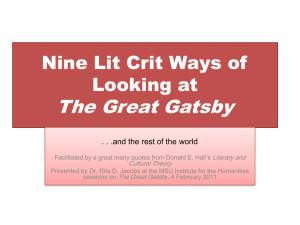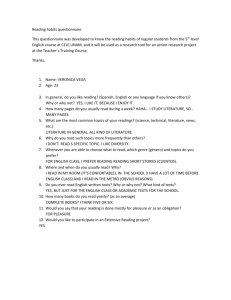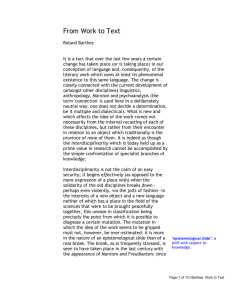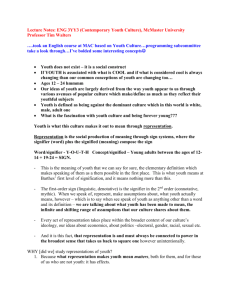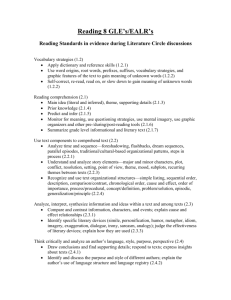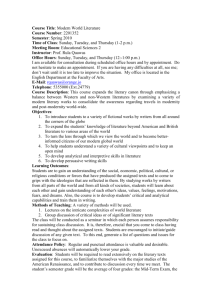From Work to Text Roland Barthes It is a fact that over the last few
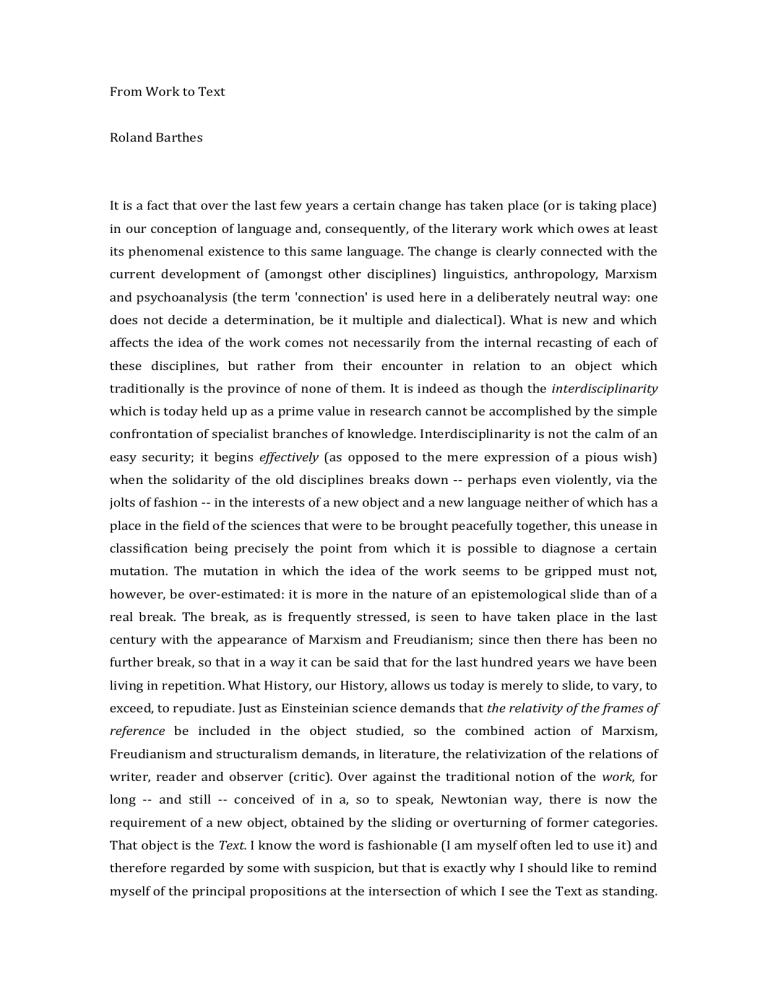
From Work to Text
Roland Barthes
It is a fact that over the last few years a certain change has taken place (or is taking place) in our conception of language and, consequently, of the literary work which owes at least its phenomenal existence to this same language. The change is clearly connected with the current development of (amongst other disciplines) linguistics, anthropology, Marxism and psychoanalysis (the term 'connection' is used here in a deliberately neutral way: one does not decide a determination, be it multiple and dialectical). What is new and which affects the idea of the work comes not necessarily from the internal recasting of each of these disciplines, but rather from their encounter in relation to an object which traditionally is the province of none of them. It is indeed as though the interdisciplinarity which is today held up as a prime value in research cannot be accomplished by the simple confrontation of specialist branches of knowledge. Interdisciplinarity is not the calm of an easy security; it begins effectively (as opposed to the mere expression of a pious wish) when the solidarity of the old disciplines breaks down -- perhaps even violently, via the jolts of fashion -- in the interests of a new object and a new language neither of which has a place in the field of the sciences that were to be brought peacefully together, this unease in classification being precisely the point from which it is possible to diagnose a certain mutation. The mutation in which the idea of the work seems to be gripped must not, however, be over-estimated: it is more in the nature of an epistemological slide than of a real break. The break, as is frequently stressed, is seen to have taken place in the last century with the appearance of Marxism and Freudianism; since then there has been no further break, so that in a way it can be said that for the last hundred years we have been living in repetition. What History, our History, allows us today is merely to slide, to vary, to exceed, to repudiate. Just as Einsteinian science demands that the relativity of the frames of reference be included in the object studied, so the combined action of Marxism,
Freudianism and structuralism demands, in literature, the relativization of the relations of writer, reader and observer (critic). Over against the traditional notion of the work , for long -- and still -- conceived of in a, so to speak, Newtonian way, there is now the requirement of a new object, obtained by the sliding or overturning of former categories.
That object is the Text . I know the word is fashionable (I am myself often led to use it) and therefore regarded by some with suspicion, but that is exactly why I should like to remind myself of the principal propositions at the intersection of which I see the Text as standing.
The word 'proposition' is to be understood more in a grammatical than in a logical sense: the following are not argumentations but enunciations, 'touches', approaches that consent to remain metaphorical. Here then are these propositions; they concern method, genres, signs, plurality, filiation, reading and pleasure.
1. The Text is not to be thought of as an object that can be computed. It would be futile to try to separate out materially works from texts. In particular, the tendency must be avoided to say that the work is classic, the text avant-garde; it is not a question of drawing up a crude honours list in the name of modernity and declaring certain literary productions 'in' and others 'out' by virtue of their chronological situation: there may be
'text' in a very ancient work, while many products of contemporary literature are in no way texts. The difference is this: the work is a fragment of substance, occupying a part of the space of books (in a library for example), the Text is a methodological field. The opposition may recall (without at all reproducing term for term) Lacan's distinction between 'reality' and 'the real': the one is displayed, the other demonstrated; likewise, the work can be seen (in bookshops, in catalogues, in exam syllabuses), the text is a process of demonstration, speaks according to certain rules (or against certain rules); the work can be held in the hand, the text is held in language, only exists in the movement of a discourse
(or rather, it is Text for the very reason that it knows itself as text); the Text is not the decomposition of the work, it is the work that is the imaginary tail of the Text; or again, the
Text is experienced only in an activity of production . It follows that the Text cannot stop (for example on a library shelf); its constitutive movement is that of cutting across (in particular, it can cut across the work, several works).
2. In the same way, the Text does not stop at (good) Literature; it cannot be contained in a hierarchy, even in a simple division of genres. What constitutes the Text is, on the contrary
(or precisely), its subversive force in respect of the old classifications. How do you classify a writer like Georges Bataille? Novelist, poet, essayist, economist, philosopher, mystic? The answer is so difficult that the literary manuals generally prefer to forget about Bataille who, in fact, wrote texts, perhaps continuously one single text. If the Text poses problems of classification (which is furthermore one of its 'social functions), this is because it always involves a certain experience of limits (to take up an expression from Philippe Sollers).
Thibaudet used already to talk -- but in a very restricted sense -- of limit-works (such as
Chateaubriand's Vie de Rancé , which does indeed come through to us today as a 'text'); the
Text is that which goes to the limit of the rules of enunciation (rationality, readability, etc.). Nor is this a rhetorical idea, resorted to for some 'heroic' effect: the Text tries to place
itself very exactly behind the limit of the doxa (is not general opinion -- constitutive of our democratic societies and powerfully aided by mass communications -- defined by its limits, the energy with which it excludes, its censorship ?). Taking the word literally, it may be said that the Text is always paradoxical .
3. The Text can be approached, experienced, in reaction to the sign. The work closes on a signified. There are two modes of signification which can be attributed to this signified: either it is claimed to be evident and the work is then the object of a literal science, of philology, or else it is considered to be secret, ultimate, something to be sought out, and the work then falls under the scope of a hermeneutics, of an interpretation (Marxist, psychoanalytic, thematic, etc.); in short, the work itself functions as a general sign and it is normal that it should represent an institutional category of the civilization of the Sign. The
Text, on the contrary, practises the infinite deferment of the signified, is dilatory; its field is that of the signifier and the signifier must not be conceived of as 'the first stage of meaning', its material vestibule, but, in complete opposition to this, as its deferred action .
Similarly, the infinity of the signifier refers not to some idea of the ineffable (the unnameable signified) but to that of a playing ; the generation of the perpetual signifier
(after the fashion of a perpetual calendar) in the field of the text (better, of which the text is the field) is realized not according to an organic progress of maturation or a hermeneutic course of deepening investigation, but, rather, according to a serial movement of disconnections, overlappings, variations. The logic regulating the Text is not comprehensive (define 'what the work means') but metonymic; the activity of associations, contiguities, carryings-over coincides with a liberation of symbolic energy
(lacking it, man would die); the work in the best of cases -- is moderately symbolic (its symbolic runs out, comes to a halt); the Text is radically symbolic: a work conceived, perceived and received in its integrally symbolic nature is a text . Thus is the Text restored to language; like language, it is structured but off-centred, without closure (note, in reply to the contemptuous suspicion of the 'fashionable' sometimes directed at structuralism, that the epistemological privilege currently accorded to language stems precisely from the discovery there of a paradoxical idea of structure: a system with neither close nor centre).
4. The Text is plural. Which is not simply to say that it .has several meanings, but that it accomplishes the very plural of meaning: an irreducible (and not merely an acceptable) plural. The Text is not a co-existence of meanings but a passage, an overcrossing; thus it answers not to an interpretation, even a liberal one, but to an explosion, a dissemination.
The plural of the Text depends, that is, not on the ambiguity of its contents but on what
might be called the stereographic plurality of its weave of signifiers (etymologically, the text is a tissue, a woven fabric). The reader of the Text may be compared to someone at a loose end (someone slackened off from any imaginary); this passably empty subject strolls
-- it is what happened to the author of these lines, then it was that he had a vivid idea of the Text -- on the side of a valley, a oued flowing down below ( oued is there to bear witness to a certain feeling of unfamiliarity); what he perceives is multiple, irreducible, coming from a disconnected, heterogeneous variety of substances and perspectives: lights, colours, vegetation, heat, air, slender explosions of noises, scant cries of birds, children's voices from over on the other side, passages, gestures, clothes of inhabitants near or far away. All these incidents are half identifiable: they come from codes which are known but their combination is unique, founds the stroll in a difference repeatable only as difference.
So the Text: it can be it only in its difference (which does not mean its individuality), its reading is semelfactive (this rendering illusory any inductive-deductive science of texts -- no 'grammar' of the text) and nevertheless woven entirely with citations, references, echoes, cultural languages (what language is not?), antecedent or contemporary, which cut across it through and through in a vast stereophony. The intertextual in which every text is held, it itself being the text-between of another text, is not to be confused with some origin of the text: to try to find the 'sources', the 'influences' of a work, is to fall in with the myth of filiation; the citations which go to make up a text are anonymous, untraceable, and yet already read : they are quotations without inverted commas. The work has nothing disturbing for any monistic philosophy (we know that there are opposing examples of these); for such a philosophy, plural is the Evil. Against the work, therefore, the text could well take as its motto the words of the man possessed by demons ( Mark 5: 9): 'My name is
Legion: for we are many.' The plural of demoniacal texture which opposes text to work can bring with it fundamental changes in reading, and precisely in areas where monologism appears to be the Law: certain of the 'texts' of Holy Scripture traditionally recuperated by theological monism (historical or anagogical) will perhaps offer themselves to a diffraction of meanings (finally, that is to say, to a materialist reading), while the Marxist interpretation of works, so far resolutely monistic, will be able to materialize itself more by pluralizing itself (if, however, the Marxist 'institutions' allow it).
5. The work is caught up in a process of filiation. Are postulated: a determination of the work by the world (by race, then by History), a consecution of works amongst themselves, and a conformity of the work to the author. The author is reputed the father and the owner of his work: literary science therefore teaches respect for the manuscript and the author's declared intentions, while society asserts the legality of the relation of author to work (the
'droit d'auteur ' or 'copyright', in fact of recent date since it was only really legalized at the time of the French Revolution). As for the Text, it reads without the inscription of the
Father. Here again, the metaphor of the Text separates from that of the work: the latter refers to the image of an organism which grows by vital expansion, by 'development' (a word which is significantly ambiguous, at once biological and rhetorical); the metaphor of the Text is that of the network ; if the Text extends itself, it is as a result of a combinatory systematic (an image, moreover, close to current biological conceptions of the living being). Hence no vital 'respect' is due to the Text: it can be broken (which is just what the
Middle Ages did with two nevertheless authoritative texts -- Holy Scripture and Aristotle); it can be read without the guarantee of its father, the restitution of the inter-text paradoxically abolishing any legacy. It is not that the Author may not 'come back' in the
Text, in his text, but he then does so as a 'guest'. If he is a novelist, he is inscribed in the novel like one of his characters, figured in the carpet; no longer privileged, paternal, aletheological, his inscription is ludic. He becomes, as it were, a paper-author: his life is no longer the origin of his fictions but a fiction contributing to his work; there is a reversion of the work on to the life (and no longer the contrary); it is the work of Proust, of Genet which allows their lives to be read as a text. The word 'bio-graphy' re-acquires a strong, etymological sense, at the same time as the sincerity of the enunciation -- veritable 'cross" borne by literary morality -- becomes a false problem: the I which writes the text, it too, is never more than a paperI .
6. The work is normally the object of a consumption; no demagogy is intended here in referring to the so-called consumer culture but it has to be recognized that today it is the
'quality' of the work (which supposes finally an appreciation of 'taste') and not the operation of" reading itself which can differentiate between books: structurally, there is no difference between 'cultured reading and casual reading in trains. The Text (if only by its frequent 'unreadability) decants the work (the work permitting) from its consumption and gathers it up as play, activity, production, practice. This means that the Text requires that one try to abolish (or at the very least to diminish) the distance between writing and reading, in no way by intensifying the projection of the reader into the work but by joining them in a single signifying practice. The distance separating reading from writing is historical. In the times of the greatest social division (before the setting up of democratic cultures), reading and writing were equally privileges of class. Rhetoric, the great literary code of those times, taught one to write (even if what was then normally produced were speeches, not texts). Significantly, the coming of democracy reversed the word of command: what the (secondary) School prides itself on is teaching to read (well) and no
longer to write (consciousness of the deficiency is becoming fashionable again today: the teacher is called upon to teach pupils to express themselves', which is a little like replacing a form of repression by a misconception). In fact, reading , in the sense of consuming, is far from playing with the text. 'Playing' must be understood here in all its polysemy: the text itself plays (like a door, like a machine with 'play') and the reader plays twice over, playing the Text as one plays a game, looking for a practice which re-produces it, but, in order that that practice not be reduced to a passive, inner mimesis (the Text is precisely that which resists such a reduction), also playing the Text in the musical sense of the term. The history of music (as a practice, not as an 'art') does indeed parallel that of the Text fairly closely: there was a period when practising amateurs were numerous (at least within the confines of a certain class) and 'playing' and 'listening' formed a scarcely differentiated activity; then two roles appeared in succession, first that of the performer, the interpreter to whom the bourgeois public (though still itself able to play a little -- the whole history of
) the piano) delegated its playing, then that of the (passive) amateur, who listens to music without being able to play (the gramophone record takes the place of the piano). We know that today post-serial music has radically altered the role of the 'interpreter', who is called on to be in some sort the co-author of the score, completing it rather than giving it
'expression'. The Text is very much a score of this new kind: it asks of the reader a practical collaboration. Which is an important change, for who executes the work?
(Mallarmé posed the question, wanting the audience to produce the book). Nowadays only the critic executes the work (accepting the play on words). The reduction of reading to a consumption is clearly responsible for the Boredom' experienced by many in the face of the modern ('unreadable') text, the avant-garde film or painting: to be bored means that one cannot produce the text, open it out, set it going .
7. This leads us to pose (to propose) a final approach to the Text, that of pleasure. I do not know whether there has ever been a hedonistic aesthetics (eudaemonist philosophies are themselves rare). Certainly there exists a pleasure of the work (of certain works); I can delight in reading and re-reading Proust, Flaubert, Balzac, even -- why not? -- Alexandre
Dumas. But this pleasure, no matter how keen and even when free from all prejudice, remains in part (unless by some exceptional critical effort) a pleasure of consumption; for if I can read these authors, I also know that I cannot re-write them (that it is impossible today to write 'like that') and this knowledge, depressing enough, suffices to cut me off from the production of these works, in the very moment their remoteness establishes my modernity (is not to be modern to know clearly what cannot be started over again ?). As for the Text, it is bound to jouissance , that is to a pleasure without separation. Order of the
signifier, the Text participates in its own way in a social utopia; before History (supposing the latter does not opt for barbarism), the Text achieves, if not the transparence of social relations, that at least of language relations: the Text is that space where no language has a hold over any other, where languages circulate (keeping the circular sense of the term).
These few propositions, inevitably, do not constitute the articulations of a Theory of the
Text and this is not simply the result of the failings of the person here presenting them
(who in many respects has anyway done no more than pick up what is being developed round about him). It stems from the fact that a Theory of the Text cannot be satisfied by a metalinguistic exposition: the destruction of meta-language, or at least (since it may be necessary provisionally to resort to meta-language) its calling into doubt, is part of the theory itself: the discourse on the Text should itself be nothing other than text, research, textual activity, since the Text is that social space which leaves no language safe, outside, nor any subject of the enunciation in position as judge, master, analyst, confessor, decoder.
The theory of the Text can coincide only with a practice of writing.
1971
Translation Copyright 1977, Stephen Heath
